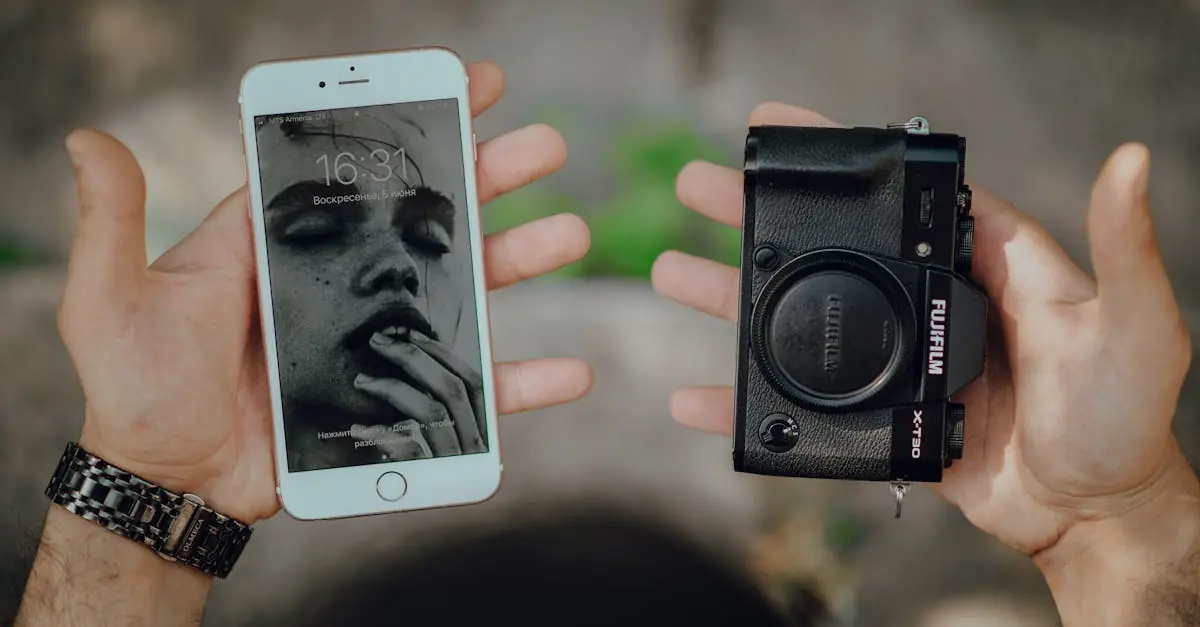Table of Contents
ToggleIn a world where capturing the perfect selfie or stunning landscape is just a click away, choosing the right smartphone camera can feel like a high-stakes game. With tech giants battling it out for the title of “best camera,” it’s easy to get lost in a sea of megapixels, apertures, and fancy marketing jargon. But fear not! This guide cuts through the noise to help anyone snap their way to Instagram glory.
Overview Of Smartphone Cameras
Smartphone cameras showcase a variety of features aimed at enhancing user photography experiences. Most models incorporate multiple lenses, such as wide-angle, macro, and telephoto, enabling diverse photographic styles. Specifications often include megapixel counts that indicate maximum image resolution; many premium devices exceed 100 megapixels.
Image processing capabilities play a crucial role in photo quality. Leading smartphones utilize advanced algorithms for noise reduction, low-light performance, and HDR (High Dynamic Range) imaging. These enhancements result in clearer images, especially in challenging conditions like dusk or bright sunlight.
Users benefit from built-in software functionalities such as portrait mode, which creates stunning depth-of-field effects. Additional features like night mode enable bright, detailed images in low-light environments without the flash. Furthermore, optical image stabilization (OIS) helps reduce blurriness caused by hand movement during shots.
Many brands prioritize video capabilities alongside traditional photography. Capture resolutions in modern smartphones can reach 4K at 60 frames per second, appealing to those interested in high-quality vlogs or social media content. Features such as slow-motion and time-lapse add more creative options for users.
Overall, smartphone cameras evolve rapidly, making it essential for photographers to stay informed about the latest advancements. Emphasis on practical applications, like shooting in challenging contexts or discovering unique lenses, assists photographers in selecting a device catering to their needs. Monitoring market trends may provide insight into which features consumers value most in their camera experiences.
Key Features In Smartphone Camera Comparison
Smartphone cameras feature various elements that influence image quality and versatility. Understanding these key features assists in making informed choices.
Megapixels And Sensor Size
Megapixels greatly impact image clarity and detail. Higher megapixels capture finer details, ideal for large prints or cropping. Sensor size affects light sensitivity; larger sensors perform better in low-light conditions. For instance, a 1/1.7-inch sensor generally outperforms a 1/3-inch sensor in dim environments. Some smartphones offer sensors exceeding 1-inch size, providing significantly enhanced image quality. Users should consider this balance of megapixels and sensor size for optimal photographs.
Lens Quality And Aperture
Lens quality greatly influences image sharpness and color accuracy. High-quality lenses produce clearer images, minimizing distortion. Aperture, measured in f-stops, controls light entry; a lower f-number (e.g., f/1.8) allows more light, enhancing low-light photography. Moreover, a wide aperture creates beautiful background blur, or bokeh, making subjects pop. Smartphone manufacturers often collaborate with optical companies to improve lens quality, providing users with superior photographic experiences.
Image Processing Software
Image processing software plays a crucial role in refining images. Advanced algorithms enhance colors, sharpness, and overall quality. Leading smartphones employ machine learning to optimize images based on conditions, such as adjusting settings for HDR or low-light scenarios. Features like portrait mode rely on software to create depth-of-field effects that mimic professional cameras. Regular updates keep software responsive to user feedback and emerging photography trends, enhancing the overall shooting experience.
Popular Smartphone Models
Various smartphone models stand out in the camera department, each offering distinct features and capabilities for photography enthusiasts.
Model 1: Specifications And Performance
The Apple iPhone 14 Pro boasts a 48-megapixel main sensor that captures impressive detail. It features advanced computational photography, enhancing low-light performance with Night mode. Users enjoy ProRAW support, allowing for deeper editing flexibility. Additionally, the device offers cinematic mode for video recording, ensuring smooth focus transitions that elevate video quality.
Model 2: Specifications And Performance
Samsung Galaxy S23 Ultra includes a versatile 200-megapixel camera system which excels in both daylight and low-light conditions. Its Super Steady video stabilization reduces shakiness in moving shots, and Space Zoom allows for powerful zoom capabilities up to 100x. Users appreciate the vivid color reproduction and excellent dynamic range, making it suitable for various photography styles.
Model 3: Specifications And Performance
Google Pixel 7 Pro features an impressive 50-megapixel main camera alongside ultra-wide and telephoto lenses. The Night Sight feature excels in low-light scenarios, producing bright, detailed images. It integrates computational photography for stunning portraits and landscape shots. Users benefit from features such as Motion Mode, adding creativity to action shots and video sequences.
Real-World Photography Comparisons
Evaluating smartphone cameras in real-world settings helps highlight their practical performance. Comparing specific features aids in selecting the most suitable device.
Low-Light Performance
Low-light capabilities significantly affect image quality in dim environments. The iPhone 14 Pro excels with its enhanced night mode, capturing clearer images through advanced computational techniques. On the other hand, the Galaxy S23 Ultra demonstrates impressive performance with larger sensor size, allowing for more light intake. The Pixel 7 Pro also excels, thanks to its sophisticated image processing algorithms that enhance detail while reducing noise. Users consistently report satisfaction with these models in low-light situations.
Portrait Mode Assessments
Portrait mode functionality offers creative flexibility, showcasing depth-of-field effects. The iPhone 14 Pro’s implementation allows for precise background blur, making subjects pop in everyday shots. Comparatively, the Galaxy S23 Ultra provides multiple focal lengths for varied perspectives, further enhancing versatility in portrait photography. The Pixel 7 Pro stands out for its ability to maintain sharpness around edges, resulting in more natural-looking portraits. Each model showcases unique strengths, making it easier for users to choose according to personal preferences.
Video Recording Capabilities
Video recording has become a critical aspect of smartphone cameras. The iPhone 14 Pro supports 4K recording across all lenses, ensuring high-quality footage in various scenarios. Users praise the Galaxy S23 Ultra’s Super Steady feature, which effectively minimizes shaky footage during movement. The Pixel 7 Pro focuses on intelligent features like Motion Mode, enabling dynamic capture with ease. Overall, these models provide competitive video quality that satisfies both casual and professional videographers seeking reliable performance.
Conclusion
Choosing the right smartphone camera involves more than just looking at megapixels or specs. It’s about understanding how each feature impacts overall image quality and usability. With advancements in technology and software, today’s smartphones offer impressive capabilities that cater to various photography styles and needs.
As users navigate their options, they should consider how features like low-light performance and video recording can enhance their photography experience. Staying updated on the latest models and their unique strengths will empower photographers to make informed decisions. Ultimately, the best smartphone camera is one that aligns with individual preferences and creative goals.




